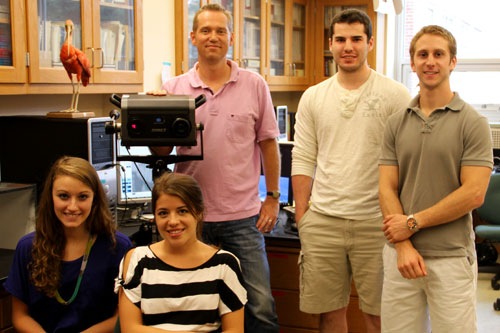TITLE “CSI Dodo: Dismantling and Digitizing the Dodo”
FACULTY-STUDENT RESEARCH TEAM Leon Claessens, associate professor of biology, with Andrew Biedlingmaier ’13, Gregory Monfette ’13, Jaclyn Vignati '14 and lab technician Jennifer Leavitt '12
WHAT THEY’RE RESEARCHING The students are working on the Aves 3D project, an online database of bones in the skeletons of living, recently extinct and fossil birds. This summer they focused on the evolution of the dodo, a large, flightless bird that went extinct in the 1600’s. “We have been dismantling 3D scans of two rare dodo skeletons we made last year so that we can finely edit each bone of the dodo individually," says Biedlingmaier. "Then, we digitally reassemble the bones of the dodo in an anatomically correct fashion. We use 3D laser surface scanners and editing software to create digital models of bird bones that we borrow from the Harvard Museum of Comparative Zoology and the Yale Peabody Museum. Using these 3D models on our database helps us to take precise measurements and compare bone morphology across bird families in ways that would be impossible or at least extremely time consuming if working with actual bones.”
WHAT THE STUDENTS GOT OUT OF IT Claessens has been working abroad at the Naturalis Centre for Biodiversity in the Netherlands this past school year. The students communicated with him via Skype. “Our professor has not been readily available this summer, so we've had to assume a greater degree of independence in learning to troubleshoot technical issues regarding our 3D models and our database. At the beginning of the summer we didn't exactly know how to use our lab's software to isolate single bones from an otherwise complete skeleton. Through much trial and error, we've been successful in segmenting these skeletons,” Biedlingmaier says.
HOW DO STUDENTS ADVANCE OR ENHANCE THE RESEARCH? “The students are an integral part of the research we undertake on bird anatomy. The 3D work is very labor intensive and without the extra manpower we would not be able to collect and edit so much data in such a short time frame,” Claessens says.
WHAT ARE THE NEXT STEPS WITH YOUR RESEARCH? The research team has placed an order to have important dodo bones printed in 3D. They will not only have digital models of this bird, but actual plastic models of selected bones as well that they can compare with other bones. “We're interested to learn how the dodo might have walked or even ran. The dodo has a reputation as a rather clumsy flightless bird, but this reputation may be undeserved. By meticulously articulating the skeleton of the dodo, and — for the first time since 1872 and with much better evidence — reconstructing muscle mass and guts, we can determine where the center of gravity of the bird may have been positioned. This is a crucial first step in our computer-based investigation of dodo motion,” says Claessens. 
During the summer, we visited five on-campus summer research teams. Take a look at their projects:
- Harvard University's Center for Hellenic Studies: "Thinking Like a Revolutionary: Interview with Homer Multitext Researcher Stephanie Lindeborg ’13"





